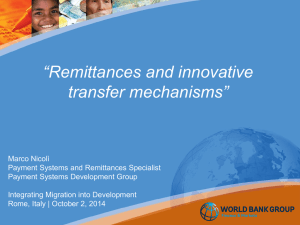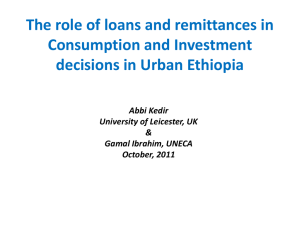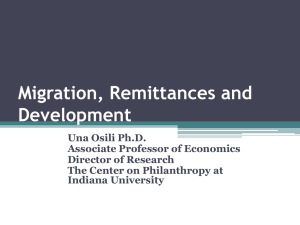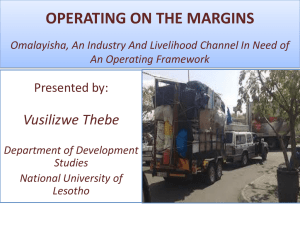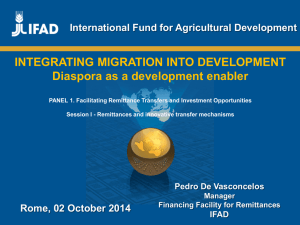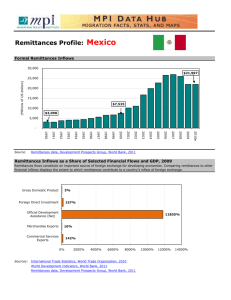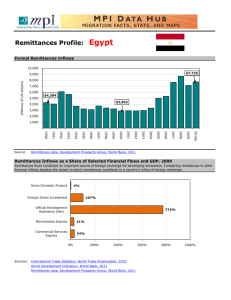The Role of Remittances in Economic Sustainability
advertisement
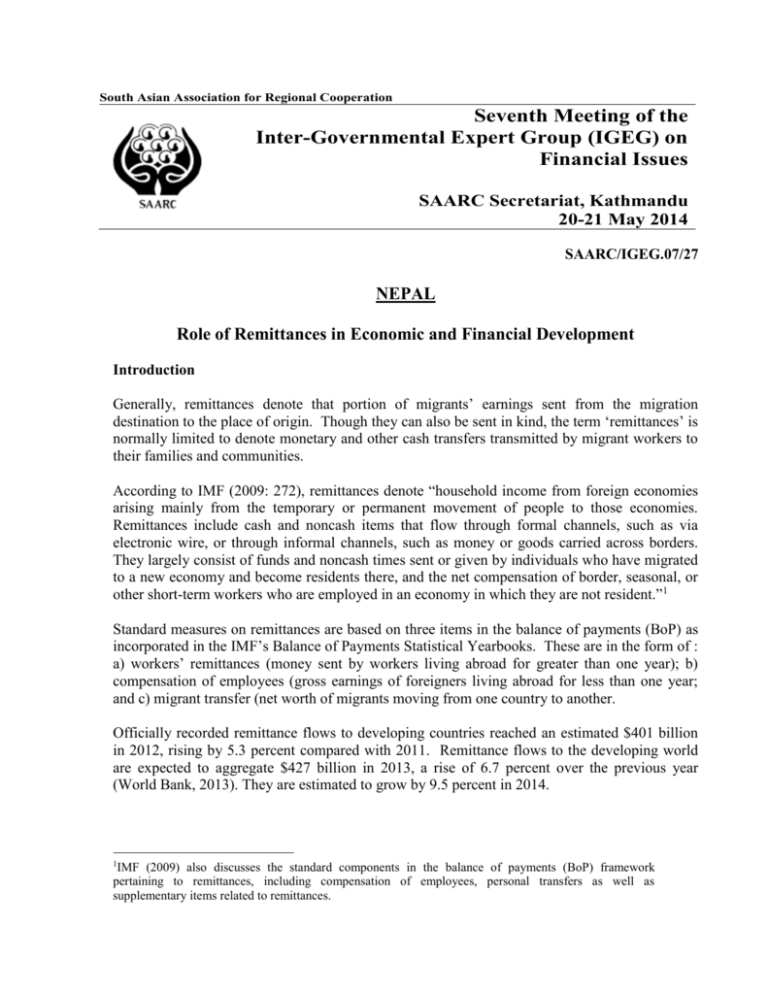
South Asian Association for Regional Cooperation Seventh Meeting of the Inter-Governmental Expert Group (IGEG) on Financial Issues SAARC Secretariat, Kathmandu 20-21 May 2014 SAARC/IGEG.07/27 NEPAL Role of Remittances in Economic and Financial Development Introduction Generally, remittances denote that portion of migrants’ earnings sent from the migration destination to the place of origin. Though they can also be sent in kind, the term ‘remittances’ is normally limited to denote monetary and other cash transfers transmitted by migrant workers to their families and communities. According to IMF (2009: 272), remittances denote “household income from foreign economies arising mainly from the temporary or permanent movement of people to those economies. Remittances include cash and noncash items that flow through formal channels, such as via electronic wire, or through informal channels, such as money or goods carried across borders. They largely consist of funds and noncash times sent or given by individuals who have migrated to a new economy and become residents there, and the net compensation of border, seasonal, or other short-term workers who are employed in an economy in which they are not resident.”1 Standard measures on remittances are based on three items in the balance of payments (BoP) as incorporated in the IMF’s Balance of Payments Statistical Yearbooks. These are in the form of : a) workers’ remittances (money sent by workers living abroad for greater than one year); b) compensation of employees (gross earnings of foreigners living abroad for less than one year; and c) migrant transfer (net worth of migrants moving from one country to another. Officially recorded remittance flows to developing countries reached an estimated $401 billion in 2012, rising by 5.3 percent compared with 2011. Remittance flows to the developing world are expected to aggregate $427 billion in 2013, a rise of 6.7 percent over the previous year (World Bank, 2013). They are estimated to grow by 9.5 percent in 2014. 1 IMF (2009) also discusses the standard components in the balance of payments (BoP) framework pertaining to remittances, including compensation of employees, personal transfers as well as supplementary items related to remittances. SAARC/IGEG.07/27 Global remittances, including those to high-income countries, are estimated to have totaled $534 billion in 2012, and projected to go up to $608 billion in 2015. However, despite the overall growth in remittance flows to developing countries, the continuing global economic crisis is dampening remittance flows to some regions, with Europe and Central Asia and Sub-Saharan Africa especially affected, while South Asia and the Middle East and North Africa (MENA) are expected to perform much better than previously estimated. The top recipients of officially recorded remittances for 2012 are India ($70 billion), China ($66 billion), the Philippines and Mexico ($24 billion each), and Nigeria ($21 billion). Other large recipients include Egypt, Pakistan, Bangladesh, Vietnam, and Lebanon. As a percentage of GDP, the top recipients of remittances in 2011 were Tajikistan (47 percent), Liberia (31 percent), Kyrgyz Republic (29 percent), Lesotho (27 percent), Moldova (23 percent), Nepal (22 percent) and Samoa (21 percent). The rest of this paper is organized as follows. The next section examines the impact of remittances on the Nepalese economy. This is followed by an analysis of the various initiatives undertaken by the concerned officials for encouraging remittance inflows through the official channel.2 Finally, the paper attempts to provide some policy options for enhancing the productive use of remittances as well as encouraging remittances through the official channel. Impact of Remittance Inflows on Nepal's Economy Generally, there are three methods of measuring remittance inflows. The first is through the BoP estimates. The second mechanism is the household surveys of recipients of such flows, for instance, the Nepal Living Standards Survey (NLSS). The third technique is through banks or financial institutions in origin countries, that is, focusing on resource transfer institutions. The size of remittance flows examined in this paper refers to the workers’ remittances under the current account of the BOP data compiled by the Research Department of Nepal Rastra Bank.3 Because of political instability prevailing in the country, many workers regard foreign employment as their only feasible option. Again, paucity of economic opportunities at home and rising employment prospects abroad have also tempted Nepalese to seek employment abroad (Seddon, 2005). According to the statistics of the Department of Labor and Employment Promotion, the number of workers going abroad for employment increased by 17.9 percent to 453,543 in 2012/13 from 384,665 in 2011/12. With the increase in the number of workers, the inflow of remittances has soared. In 2012/13, remittances aggregated USD 4.93 billion, a rise by 11.7 percent compared to USD 4.41 billion in 2011/12.4 Likewise, the remittances to GDP ratio 2 It should be mentioned at the outset that internal remittances (defined as the money and/or goods sent to rural areas from urban areas by migrant workers) are equally important from a development perspective. For instance, Adams (1997) has demonstrated that in Pakistan while external remittances have a positive and significant impact on the accumulation of land, internal remittances have a significant and positive effect on the accumulation of agricultural capital. DeWind and Holdaway (2005) have also made a comprehensive analysis on the significance of internal remittances. 3 Since remittances are transmitted through different channels, it is an arduous task to capture the full amount in the BOP statistics. As a result, it is difficult to come up with strong and valid conclusions on the role of remittances in the economic development of the country. 4 The data are taken from NRB (2012, 2013). 2 SAARC/IGEG.07/27 increased from 10.7 percent in 2000/01 to 13.8 percent in 2006/07 and further to 25.5 percent in 2012/13. The upward movement in remittances has led to a surplus in the current account, subsequently strengthening the overall BoP position. The share of remittances in total current account receipts, for instance, rose from 27.4 percent in 2000/01 to 61.2 percent in 2012/13. Remittances have also eased foreign exchange constraints of the country. One of the major factors responsible for the growth of convertible currency reserves of the banking system in recent years has been the rise in remittances. The gross foreign exchange reserves were sufficient for financing merchandize imports of 11.7 months and merchandize and service imports of 10.1 months as at mid-July 2013 compared to 11.6 months and 10.3 months respectively in mid-July 2012. These illustrations denote that any sizeable drop in receipts from remittances could disturb the structure of the economy from the macro level. The impact of remittances on national economy can also be illustrated by the fact that it has surpassed exports as the top contributor in the foreign exchange earnings of the country after 2001/02. While the share of remittances in total foreign exchange receipts has been 31.5 percent, 41.2 percent and 59.3 percent in 2000/01, 2006/07 and 2012/13, respectively, the corresponding share of exports was 46.6 percent, 25.3 percent and 11.7 percent. The share of tourism receipts in total foreign exchange receipts, on the other hand, went down to 4.2 percent in 2006/07 from 7.8 percent in 2000/01 but went up slightly to 4.7 percent in 2012/13. An increasingly larger share of remittances now comes from countries other than India, demonstrating changing migration patterns and higher earnings in these locations. Moreover, the composition of skills of the labor flows is different among destinations. While migrants to the Middle East are employed mostly as security personnel, chauffeurs, and construction workers, the demand from South East Asian countries is more for employment in industrial enterprises. Migrants to India, on the other hand include semi-skilled and unskilled jobs in restaurants and factories or are employed as domestic workers, security guards, and maids. Conclusions relating to the impact of remittances can vary depending on the analytical approach adopted. Regardless of the approach used, studies on the poverty impact of remittances have revealed that apart from possibly increasing inequality and dependency, remittances make an important contribution to reducing poverty and vulnerability in most households and communities. In Nepal’s case, the impact of remittances on poverty has been positive as the headcount poverty ratio declined from 41.8 percent in 1995/96 to 30.8 percent in 2003/4 and further to 25.2 percent in 2010/11 (CBS, 2011a). Efforts towards Mobilizing Remittances Owing to the positive impact of remittances, the country has given priority in promoting overseas employment and mobilizing remittances so as to maximize the benefits from these transfers. In this respect, effective 29 March 2002, the Nepal Rastra Bank (NRB) had begun granting licenses to private sector organizations interested in remittance-transfer business. As of 15 July 2013, 47 firms besides the commercial banks are undertaking money transfer businesses. 3 SAARC/IGEG.07/27 Different policy provisions have also been carried forward for encouraging remittances through the banking channel. For instance, the NRB had arranged to provide 15 paisa per US dollar as commission to licensed private firms in addition to the prevailing buying rate (NRB, 2002). Moreover, permission was granted to manpower agencies, engaged in sending Nepalese nationals to work overseas, to open foreign currency account in the Nepalese commercial banks out of the foreign currency income that they realized under the prevailing rules. If a Nepal-based licensed agent/representative of any money transfer company situated overseas requires bank guarantee for the purpose of receiving advance payment from the principal company, a policy arrangement of making such facility available, within the stipulated limits, directly from the commercial banks was introduced beginning FY 2004/05 (NRB, 2004). This measure has facilitated the licensed agents in making instant payments of the remittance to the related parties. Similarly, as per Monetary Policy of 2013/14, an arrangement would me made so that remittance companies and moneychangers will obtain the facility to exchange foreign currency that they have collected in the market from NRB. Similarly, a provision of issuing 'Prepaid Remittance Card' by the remittance companies is to be introduced to deliver the remitted amount collected by remittance companies to the family member of migrant workers (NRB, 2013a). In terms of uses, however, it has been revealed that remittances in Nepal have been used very little for productive purposes. A study conducted by NRB (2002a), covering 10 districts and 160 sample households, showed that the remittance earnings were largely invested for household purposes, purchase of real estate and house, paying off the loan, purchase of jewellery and as bank deposits. Policy Prescriptions Policies are needed to encourage the use of remittances to promote longer-term growth and income security. Nepal needs to further formulate policies that a) send more remittances through official rather than unofficial mechanisms, b) increase the levels of remittances by encouraging migrants to hold their savings in financial assets in the country rather than holding them abroad, or c) encourage migrants to become investor in productive assets in the country. A favorable interest rate policy, a market-determined and realistic exchange rate and limited restrictions on withdrawals are also crucial. In building these products, policymakers should keep in mind that migrants and their families constitute a diverse group, ranging from whitecollar workers to the illiterate and poor. Moreover, policies formulated to mobilize remittances should also be preceded by policies to promote other sources of foreign exchange to relieve the pressure on the foreign exchange pools and maintain stable exchange rates. Consistent interest rates should also be accompanied by policies to curb inflationary pressures. The establishment of a special category of deposit accounts at commercial banks where migrants can deposit their money earned abroad is one of the most common incentives used in many countries to attract money transfers from abroad. These special deposit accounts give migrants preferential interest rates and the option to have accounts denominated in foreign currency. 4 SAARC/IGEG.07/27 Human capital should be developed in accordance with the demands of the international labor market and this should constitute an integral part of the overseas employment process in Nepal. Business facilitation for returnees must be given due emphasis. Policymakers should welcome the returnees—who will come back with skills, entrepreneurship and capital—instead of treating them as a burden. Policies to re-integrate the returnees can include improving self-employment opportunities, support for small and medium-enterprises (SMEs), and budget support to districts facing large returns. Pooling remittances in microfinance institutions (MFIs) with regard to deposits enables MFIs to finance a wide range of activities, and generate a potentially greater economic and social impact than what could be viable with special targeted business development programs. Moreover, MFIs themselves can utilize remittances to leverage more funds in the commercial markets to finance their growing lending operations (Pant, 2011). This will enable the MFIs both to diversify their funding sources and also increase the breadth and depth of their outreach. Over time, with more experience, innovative MFIs will find different ways of turning workers’ remittances into a productive business that would contribute to their social mission and profitability. Banks could make MFIs their working partners in the rural sector for undertaking microfinance activities. The MFIs would play the role of loan service agents, and collaborate with social entrepreneurs to set up greenfield MFIs. Under this arrangement, each bank or group of banks could develop microfinance loan portfolio by accumulating the remittances they receive from migrant workers and establishing a network that could eventually distribute a range of financial services throughout the rural areas. As a result, commercial banks would also benefit from the potential of the microfinance sector. Pre-departure orientation program and information dissemination in the destination countries could act as an important mechanism in raising awareness about remittance methods and utilization. Moreover, returnee migrants also have a crucial role to play as they can share their experiences with future migrants and their families. Overall, the involvement of a variety of actors (migrant associations, NGOs and governmental bodies) is instrumental in the success of these initiatives. It is crucial to encourage migrant knowledge transfer and organization of migrant groups for business development. Diaspora communities are not only a source of funding for projects, but also an important source of human capital, which could well be used in Nepal. Due to their attachment, many migrants could thus be mobilized to assist in projects in Nepal, not just through financial contributions, but also by offering time and knowledge. Nepal needs to develop a website to make available information to migrants on remittances transfer mechanisms, prices, and speed and reliability that could improve transparency and further competition in the remittance industry. The website could also give information on investment opportunities back home, immigration policies in destination countries and links to 5 SAARC/IGEG.07/27 websites of the Nepal government and non-government institutions that work with the Diaspora, return migrants, micro-credit institutions, and business development. At household level, the government could enhance the developmental impact of remittances by giving migrants additional incentives. For example, they could be allowed to open foreign currency accounts in the home country, and the interest rate on deposits denominated in foreign currencies could be exempted from wealth and income taxes; an option to use foreign currency deposits as collateral for obtaining preferential loans could be offered; the creation of education and housing accounts at home for migrants and their families, combined with a higher rate of return on these deposits than on ordinary ones, would provide an incentive to save more out of remittances, for purposes that would encourage productive use of remittances. In the context when the government, private and public sector has acknowledged the contribution of remittance in the economy, it is high time to mainstream the foreign labor migration in government planning process. By reducing the transaction cost associated with the process, diversifying the destination countries and making it a reliable and affordable medium of earning money, the government can address the problem appropriately. In effect, an agency, ideally at ministerial level, is required to a) deal with the cross-cutting nature of these issues, b) ensure policy coherence and consistency across the board, and c) coordinate potential actors around a set of identified priorities. For example, the Government of Bangladesh, responding to demands by expatriate Bangladeshis, created a Ministry of Expatriates’ Welfare and Overseas Employment in 2001. Its prime function is the creation, promotion and regulation of employment overseas. One important motive for promoting employment abroad is to ensure a steady flow of remittances. Conclusions Despite the lack of accurate data on the real volume of funds transferred, there is ample evidence that remittance flows are substantial, stable relative to other forms of development finance, and well-targeted to vulnerable families, both as support during a crisis and as an income-smoothing mechanism. In Nepal, during the last few years, remittances have been an important avenue of support for family members remaining at home. As the number of workers going abroad for employment continues to rise, the corresponding growth of remittances has become a critical flow of foreign currency into Nepal. 6 SAARC/IGEG.07/27 Selected References Adams, Richard H., Jr. 1997. “Remittances, Income Distribution and Rural Asset Accumulation.” Available in: http://www.ifpri.org/fncd/dp/papers/dp17. Central Bureau of Statistics. 2011. Nepal Living Standards Survey 2010/11. Kathmandu: Central Bureau of Statistics. Central Bureau of Statistics. 2011a. "Poverty in Nepal in 2010/11." Kathmandu: Central Bureau of Statistics. DeWind, Josh and Jennifer Holdaway. 2005. “Internal and International Migration in Economic Development.” Available in: http://www.un.org/esa/population/publications International Monetary Fund (IMF). 2009. Balance of Payments and International Investment Position Manual (BPM6). Washington, D.C.: IMF. Nepal Rastra Bank. 2004. Monetary Policy and Program for FY 2004/05. Kathmandu: Nepal Rastra Bank. Nepal Rastra Bank. 2002. Monetary Policy and Program for FY 2002/03. Kathmandu: Nepal Rastra Bank. Nepal Rastra Bank. 2002a. Foreign Employment and the Remittance Economy of Nepal (in Nepali). Kathmandu: Nepal Rastra Bank. Nepal Rastra Bank. 2012. Quarterly Economic Bulletin 47:1. Kathmandu: Nepal Rastra Bank. Nepal Rastra Bank. 2013. "Current Macroeconomic Situation of Nepal (Based on Annual Data of 2012/13)." Kathmandu: Nepal Rastra Bank. Nepal Rastra Bank. 2013a. Monetary Policy and Program for FY 2013/14. Kathmandu: Nepal Rastra Bank. Pant, Bhubanesh Pant. 2011. "Harnessing Remittances for Productive Use in Nepal." NRB Economic Review, 23, April. Seddon, David. 2005. “Nepal’s Dependence in http://www.migrationinformation.org/Profiles/display Exporting Labor.” Available World Bank. 2013. Migration and Development Brief 20. Washington, DC.: World Bank. ______ 7 in:
